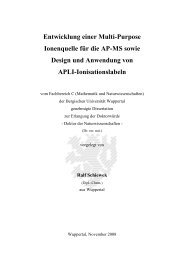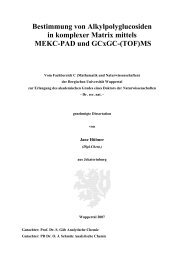The Influence of Oxidative Stress, Carcinogens and Cloning on DNA ...
The Influence of Oxidative Stress, Carcinogens and Cloning on DNA ...
The Influence of Oxidative Stress, Carcinogens and Cloning on DNA ...
Create successful ePaper yourself
Turn your PDF publications into a flip-book with our unique Google optimized e-Paper software.
31<br />
Introducti<strong>on</strong><br />
phologically, both diseases showed extensive hypocellular interstitial sclerosis, tubular atrophy,<br />
glomerulosclerosis <str<strong>on</strong>g>and</str<strong>on</strong>g> urothelial atypia associated with the possibility <str<strong>on</strong>g>of</str<strong>on</strong>g> malignant<br />
transformati<strong>on</strong> <str<strong>on</strong>g>of</str<strong>on</strong>g> the urothelium (314, 336, 337) . Both are linked to the exposure to AA either<br />
through the intake <str<strong>on</strong>g>of</str<strong>on</strong>g> herbal remedies prepared from Aristolochia plants or the ingesti<strong>on</strong> <str<strong>on</strong>g>of</str<strong>on</strong>g><br />
c<strong>on</strong>taminated wheat-made products.<br />
Aristolochic acids are nephrotoxic <str<strong>on</strong>g>and</str<strong>on</strong>g> carcinogenic nitroaromatic compounds via the producti<strong>on</strong><br />
<str<strong>on</strong>g>of</str<strong>on</strong>g> AA- <strong>DNA</strong> adducts which were detected in the kidney <str<strong>on</strong>g>and</str<strong>on</strong>g> ureter <str<strong>on</strong>g>of</str<strong>on</strong>g> AAN patients (338) .<br />
Different studies had reported AA as nephrotoxic, potent carcinogen in laboratory animals<br />
(339-342) (343) (341, 344, 345)<br />
<str<strong>on</strong>g>and</str<strong>on</strong>g> man as well as genotoxic mutagen . After enzymatic activati<strong>on</strong> (cytochrome<br />
P450 <str<strong>on</strong>g>and</str<strong>on</strong>g> peroxidase) (346) aristolactams (347) are the activated metabolites formed by<br />
AA nitroreducti<strong>on</strong> (348) <str<strong>on</strong>g>and</str<strong>on</strong>g> form major <strong>DNA</strong> adducts (349) through the attack <str<strong>on</strong>g>of</str<strong>on</strong>g> aristolactamnitrinium<br />
i<strong>on</strong> to the exocyclic amino group <str<strong>on</strong>g>of</str<strong>on</strong>g> adenosine <str<strong>on</strong>g>and</str<strong>on</strong>g> guanosine (315, 349) (Fig. 15). <str<strong>on</strong>g>The</str<strong>on</strong>g><br />
AA–<strong>DNA</strong> adducts can be used as potential biomarkers <str<strong>on</strong>g>of</str<strong>on</strong>g> AA toxicity (167) .<br />
Certain genes are associated with different mutati<strong>on</strong>s in resp<strong>on</strong>se to AA exposure, such as<br />
TP53 (350) . This gene was found to be mutated in 50% <str<strong>on</strong>g>of</str<strong>on</strong>g> the recorded human cancers (351) <str<strong>on</strong>g>and</str<strong>on</strong>g><br />
was recently identified in some AA-induced tumours (343, 351, 352) . <str<strong>on</strong>g>The</str<strong>on</strong>g> p53 mutati<strong>on</strong>al spectra<br />
<str<strong>on</strong>g>of</str<strong>on</strong>g> these cancers are dominated by the type <str<strong>on</strong>g>of</str<strong>on</strong>g> AT-TA transversi<strong>on</strong>s (284) , resembling the mutati<strong>on</strong>al<br />
behaviour observed in urothelial cancer patient (353) as well as in H-ras <strong>on</strong>cogene in ro-<br />
dents exposed to AA dosage (354, 355) .




